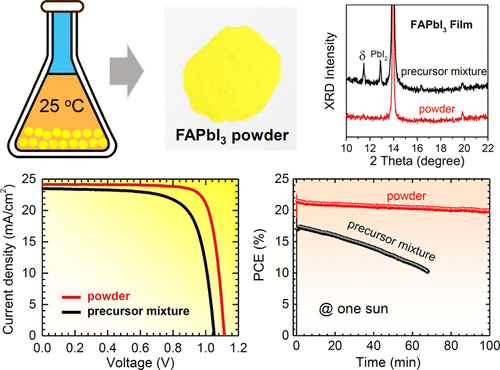当前位置:
X-MOL 学术
›
ACS Energy Lett.
›
论文详情
Our official English website, www.x-mol.net, welcomes your
feedback! (Note: you will need to create a separate account there.)
Achieving Reproducible and High-Efficiency (>21%) Perovskite Solar Cells with a Presynthesized FAPbI3 Powder
ACS Energy Letters ( IF 19.3 ) Pub Date : 2020-01-08 , DOI: 10.1021/acsenergylett.9b02348 Yong Zhang 1 , Seongrok Seo 2 , Soo Yeon Lim 3 , Younghoon Kim 2 , Seul-Gi Kim 1 , Do-Kyoung Lee 1 , Sun-Ho Lee 1 , Hyunjung Shin 2 , Hyeonsik Cheong 3 , Nam-Gyu Park 1
ACS Energy Letters ( IF 19.3 ) Pub Date : 2020-01-08 , DOI: 10.1021/acsenergylett.9b02348 Yong Zhang 1 , Seongrok Seo 2 , Soo Yeon Lim 3 , Younghoon Kim 2 , Seul-Gi Kim 1 , Do-Kyoung Lee 1 , Sun-Ho Lee 1 , Hyunjung Shin 2 , Hyeonsik Cheong 3 , Nam-Gyu Park 1
Affiliation

|
The conventional precursor mixture based on highly pure and expensive PbI2 (purity >99.99%) is problematic in commercializing perovskite solar cells (PSCs) because of a large deviation in the batch-to-batch photovoltaic performance due to underlying nonstoichiometry and/or the nonperovskite phase. Here, we report on reproducibly efficient (>21%) PSCs based on the ambient-temperature-stable δ-phase FAPbI3 powder, synthesized by reacting PbI2 (either homemade or low-grade commercial product with purity <99%) with formamidinium iodide (FAI) at room temperature (∼93% yield). X-ray diffraction patterns confirm that annealing the spin-coated film leads to phase purity of cubic α FAPbI3. As compared to the conventional precursor mixture based on PbI2 (purity = 99.9985%), significantly reducing defects in the powder-based film is responsible for the stable and reproducible efficiency. In addition, the homogeneous light-intensity-dependent surface photocurrent contributes to the reproducibility of photovoltaic performance. The quasi-steady-state power conversion efficiency of 21.07% is certified for the device based on FAPbI3 powder.
中文翻译:

预先合成的FAPbI 3粉末可实现可再生且高效(> 21%)的钙钛矿太阳能电池
基于高纯度和昂贵的PbI 2(纯度> 99.99%)的常规前驱物混合物在钙钛矿型太阳能电池(PSC)的商业化中存在问题,因为由于潜在的非化学计量和/或化学性质,批次之间的光伏性能存在较大差异。非钙钛矿相。在此,我们报告了基于环境温度稳定的δ相FAPbI 3粉末的可再生有效(> 21%)PSC,该粉末是通过使PbI 2(纯度低于99%的自制或低档商业产品)与甲ami反应而合成的室温下碘化物(FAI)(约93%的收率)。X射线衍射图证实,对旋涂膜进行退火可导致立方晶αFAPbI 3的相纯度。与传统的基于PbI 2的前体混合物(纯度= 99.9985%)相比,粉末状薄膜中缺陷的明显减少是稳定和可重复生产的效率的原因。另外,依赖于光强度的均匀表面光电流有助于光伏性能的可再现性。基于FAPbI 3粉末的器件的准稳态功率转换效率为21.07%。
更新日期:2020-01-10
中文翻译:

预先合成的FAPbI 3粉末可实现可再生且高效(> 21%)的钙钛矿太阳能电池
基于高纯度和昂贵的PbI 2(纯度> 99.99%)的常规前驱物混合物在钙钛矿型太阳能电池(PSC)的商业化中存在问题,因为由于潜在的非化学计量和/或化学性质,批次之间的光伏性能存在较大差异。非钙钛矿相。在此,我们报告了基于环境温度稳定的δ相FAPbI 3粉末的可再生有效(> 21%)PSC,该粉末是通过使PbI 2(纯度低于99%的自制或低档商业产品)与甲ami反应而合成的室温下碘化物(FAI)(约93%的收率)。X射线衍射图证实,对旋涂膜进行退火可导致立方晶αFAPbI 3的相纯度。与传统的基于PbI 2的前体混合物(纯度= 99.9985%)相比,粉末状薄膜中缺陷的明显减少是稳定和可重复生产的效率的原因。另外,依赖于光强度的均匀表面光电流有助于光伏性能的可再现性。基于FAPbI 3粉末的器件的准稳态功率转换效率为21.07%。

































 京公网安备 11010802027423号
京公网安备 11010802027423号